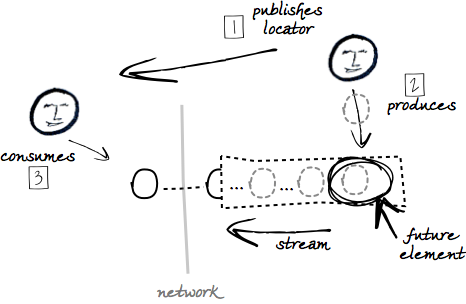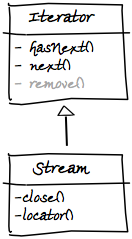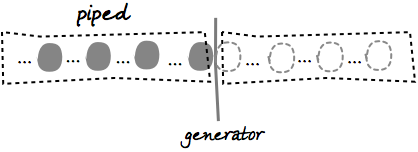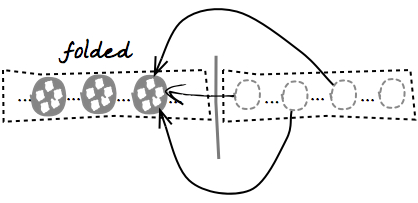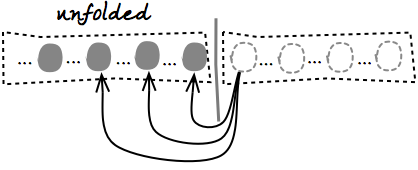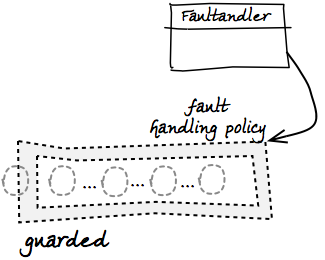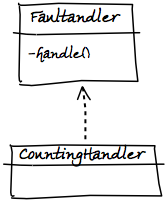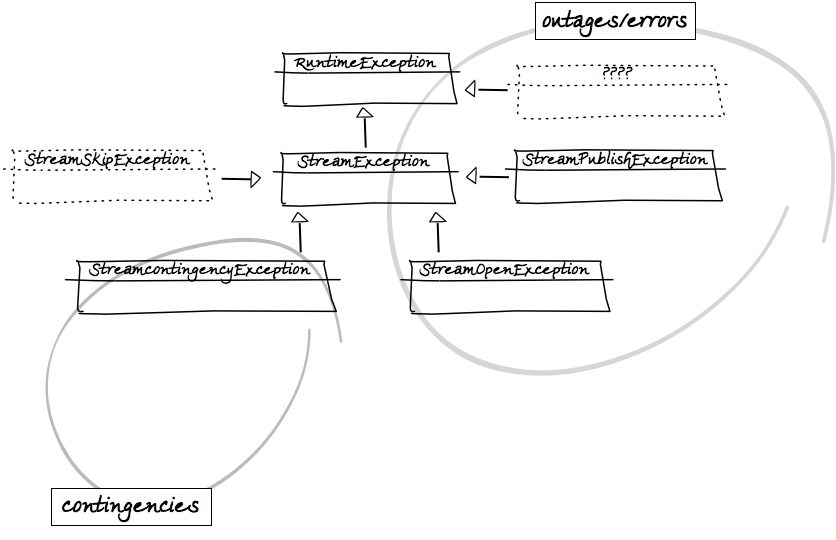The Streams Library
The streams library implements a domain-specific language (DSL) for working with data streams.
Built around an extension of the familiar Iterator interface, the language can be used to:
- map, filter, group, and ungroup the elements of input streams into elements of output streams;
- configure handling policies stream iteration failures;
- receive notifications of stream iteration events;
- consume gCube ResultSets as streams and publish streams as gCube ResultSets;
- consume streams through callbacks, rather than explicit iteration.
Contents
- 1 Streams
- 2 Use Cases
- 3 Programming over Streams
- 4 The Stream Interface
- 5 The Stream Language
- 6 Adapting Plain Iterators
- 7 Adapting Resultsets
- 8 Piping Streams
- 9 Folding and Unfolding Streams
- 10 Guarding Streams
- 11 Monitoring Streams
- 12 Logging Streams
- 13 Publishing Streams
- 14 Putting it Together
Streams
A stream is a lazily-evaluated sequence of data elements. Consumers process the elements as these become available, and discard them as soon as they are no longer required. This is of value when the sequence is large and originates from secondary storage or the network. Consumers need not wait for the entire dataset to become available before they can start to process it, nor do they need to fit it in main memory. This keeps them responsive when working at large scale.
For its advantages, streaming is used heavily throughout the system as the preferred method of asynchronous data transfers between clients and services. The gRS2 library provides the required API and the underlying implementation mechanisms, including paged transfers and memory buffers which avoid the cumulative latencies of many fine-grained interactions. The gRS2 API allows services to “publish” streams, make them available at a network endpoint through a given protocol. Clients obtain references to such endpoints, i.e. stream locators, and clients resolve locators to iterate over the elements of the streams. Services produce elements as clients require them, i.e. on demand.
Use Cases
Data streaming is used in a number of use cases, including:
- a service streams the elements of a persistent dataset;
- a service streams the results of a query over a persistent dataset;
- a service derives a stream from a stream provided by the client;
The last is a case of circular streaming. The client consumes a stream A which is produced by the service by iterating over a stream B, which is produced by the client. Examples of circular streaming include:
- bulk lookups, e.g. clients retrieve the elements of a remote dataset which have given identifiers;
- bulk updates, e.g. clients retrieve the outcomes of adding elements to a remote dataset;
More complex uses cases involve multiple streams, producers, and consumers. As an example that combines lookups and updates, consider the case of a client that:
- obtains a locator to a stream
S1of element identifiers published by a serviceA; - passes the locator of
S1to another serviceBin order to get back the locator of a streamS2of elements resolved from the identifiers; - processes the elements in
S2in order to update some of their properties; - publishes a stream
S3of updated elements and passes its locator back toBso as to have the updates committed; - obtains from
Bthe locator of a streamS4of commit outcomes, and consumes it to report or otherwise handle the failures that may have occurred in the process.

Programming over Streams
The advantages of data streaming are offset by an increased complexity in the programming model. Consuming a stream can be relatively simple, but:
- the assumption of external data puts more emphasis on correct failure handling;
- since streams may be partially consumed, resources allocated to streams at the producer’s side need to be explicitly released;
- consumers that act also as producers need to remain within the stream paradigm, i.e. avoid the accumulation of data in main memory as they transform elements of input streams into elements of outputs streams;
- implementing streams is typically more challenging that consuming streams. Filtering out some elements or absorbing some failures requires look-ahead implementations. Look-ahead implementations are notoriously error prone;
- stream implementations are typically hard to reuse (particularly look-ahead implementations);
The rich use case outlined above illustrates the issues. Throughout the workflow, the client needs to interleave the consumption of two streams (S1, S3) with the generation of a third stream (S2). identifiers come from A as elements come from B, as updated elements move towards B, and as outcomes flow back from B. The client is responsible for implementing S2. At any time, client and services may observe a wide range of failures, some recoverable and some fatal.
Thus streaming raises significant opportunities as well as non-trivial programming challenges. The gRS2 API provides sophisticated primitives for data transfer, but it remains fairly low-level when it comes to producing and consuming streams. The streams library provides the abstractions required to simplify stream-based programming in scenarios such as the one above.
The Stream Interface
The streams library revolves around the model defined by the Stream interface. The interface defines an API for iterating over streams of homogeneously typed elements. The API extends the standard Iterator API to reflect the arbitrary origin of the data, which includes memory, secondary storage, and network.
The interface shows that Streams are:
- addressable (cf.
locator()) i.e. return a URI reference to their address. The precise form and use of such stream locators is implementation-dependent. For example, when the stream originates from the network, the locator will reference the endpoint of a remote service which can serve the data through some protocol;
- closable (cf.
close()), i.e. may be told to release computational resources allocated for their production and consumption. Consumers close streams to free up their own resources, and to signal producers that they may do the same. This is an idempotent operation, i.e. can be invoked an arbitrary number of times because it has no side-effects. A closedStreamcan no longer be iterated over:hasNext()will return false, andnext()will throwNoSuchElementExceptions.
Streams may raise a broader range of failures than Iterators defined over in-memory collections:
-
locator()may return anIllegalStateExceptionif the implementation does not allow consuming the stream more than once. For example, theStreamimplementation based on gCube Resultsets does not return locators afterhasNext()ornext()have been invoked;
-
next()may return a wide range of failures (beyond the usualNoSuchElementExceptionandConcurrentModificationException). Later on, we will discuss in detail the nature of such failures and the strategies that are available to handle them.
note: hasNext() and close() do not return failures (other than implementation errors, of course). This aligns with standard expectations for hasNext(), but less so for close() (e.g cf. Closeable.close()). The justification for this is that clients cannot normally recover from closing failures, only log them and debug them. The Stream API leaves implementations responsible for logging or, when appropriate, retrying it. Clients have only the onus of enabling the logs.
Due the increased likelihood of failures and the need to release resources, a safe idiom for Stream consumption is the following:
Stream<MyElement> stream = ...
try {
while (stream.hasNext()) {
....stream.next()...
}
finally {
stream.close();
}
With this idiom, Stream implementations release resources regardless of whether all its elements have been iterated over, e.g. when clients terminate abruptly due to a failure or an intentional early exit (a break in the main loop).
The Stream Language
Based on the Stream interface, the streams library implements an embedded Domain-Specific Language (eDSL) of stream sentences.
Sentences are comprised of clauses. Based on the verb clause that starts a sentences, we distinguish between:
-
convertsentences: adapt existing stream implementations to theStreaminterface (e.g.Iteratorimplementations and gCube Resultsets implementations). The resultingStreams can then be manipulated further within the language;
-
pipesentences: transform elements of givenStreams into elements of newStreams;
-
foldsentences: group elements of givenStreams into elements of newStreams;
-
unfold<code> sentences: expands elements of given <code>Streams into many elements of newStreams;
-
guardsentences: configureStreams with given fault handling policies;
-
monitorsentences: configureStreams with iteration event listeners;
-
logsentences: logStreams throughput;
-
publishsentences: makeStreams available to remote consumers;
-
consumesentences: consumeStreams by passing their elements to callbacks;
All the verb clauses above are implemented as static methods of the Streams class. The methods return objects that capture the state of the sentence under construction. These objects offer instance methods that allows us continue the construction of the sentence in a type-safe manner.

For example, to fold a Stream of strings into a Stream of 10-string elements, we write:
Stream<String> strings = ... Stream<List<String>> folded = Streams.fold(strings).in(10);
We can use a static import on the whole Streams class to improve the fluency of the code
[1]:
import static org.gcube.data.streams.dsl.Streams.*; ... Stream<String> strings = ... Stream<List<String>> folded = fold(strings).in(10);
In what follows, we discuss fold sentences and all the other sentence types in detail.
- ↑
IDEs can be configured to generate a ‘star’ static import as soon as one static method is imported. InEclipse, for example, seePreferences/Java/Code Style/Organise Imports. This means that we can writeStreams.fold()within a new class, use a shortcut to importfold(), and have all other verbs of the eDSL imported too.
Adapting Plain Iterators
The simplest sentences of the stream eDSL are those that turn a standard Iterator into a Stream:
Iterator<String> strings = ... Stream<String> stream = convert(strings);
We may use this interface conversion over streams based on in-memory collections. This is useful for testing, but also when services return data in collections or arrays, i.e. when they are not designed for streaming. We can then turn the data into streams, publish them (we will see it later how), and then push them towards another service that expects data in this form.
We can of course convert any Iterator implementation (e.g. persistent datasets), not only those returned by the standard Collections API. As a case in point, we can convert directly from Iterables:
List<String> strings = Arrays.asList(“1”,”2”,”3”); Stream<String> stream = convert(strings);
In all cases, the conversions make the datasets eligible to further manipulation with our eDSL.
By default, the Iterators are expected to be over in-memory collections. Invoking locator() on the adapted Stream returns a pseudo URI of the form local://to-string, where to-string is the output of the toString() method of the Iterator. Clearly, a local locator serves solely for debugging purposes and cannot be resolved. Similarly, invoking close() on the adapted Stream has an effect only if the Iterator implements the Closeable interface. In this case, the stream simply delegates to the Iterator.
We may override these defaults by extending IteratorAdapter and overriding its locator() and/or close() methods, as appropriate. For example, if we know that the original Iterator streams the contents of a given file, we may extend IteratorAdapter as follows:
IteratorAdapter fileAdapter = new IteratorAdapter(strings) {
@Override URI locator() {
return URI.create(“file://...”);
}
};
and then obtain a Stream from it as follows:
Stream<String> stream = convert(fileAdapter);
Adapting Resultsets
We can also use convert gCube Resultsets into Streams. The starting point is now a URI locator to the Resultset:
URI rs = ... Stream<MyRecord> stream = convert(rs).of(MyRecord.class).withDefaults();
Here we have assumed the Resultset is comprised of custom MyRecords and we have used default settings for the translation. We can also use pre-defined record types, such as GenericRecord, as well as act on the read timeout:
Stream<GenericRecord> stream = convert(rs).of(GenericRecord.class).withTimeout(1,TimeUnit.MINUTES);
A common use of GenericRecords within the system is to carry string serialisation of elements in a single field. Effectively, this marks an “untyped” use of the Resultset mechanism. In this case, we can simplify the sentence further, e.g.:
Stream<String> stream = convert(rs).ofStrings().withDefaults();
Note that, since streams are based on memory buffers at both consumer and producer ends, Resultset can no longer be consumed after we’ve started iterating over their elements. If we invoke locator() after hasNext() or next() we will raise an IllegalStateException.
Piping Streams
Given a Stream, we can transform its elements into elements of another Stream. The simplest transformations are one-to-one: for each element of the input stream we generate an element of the output stream.
Visually, it’s as if we were piping the input stream into the output stream and see the elements that enter at one end of the resulting pipe come out changed as they exit at the other end. We may of course change the type of elements as they flow through the pipe, or update them in place. While we can define arbitrarily complex transformations, we will normally keep them simple: parse strings into objects, serialise objects into strings, extract selected information from objects, change that information, create new objects from that information, and so on.
We define transformations by implementing the Generator interface, e.g.:
Generator<String,Integer> sizer = new Generator<String, Integer>() {
public Integer yield(String element) {
return element.length();
}
};
and then use the Generator in a pipe sentence, as follows:
Stream<String> strings = ... Stream<Integer> lengths = pipe(strings).through(sizer);
When we need to update the elements of the input stream, we can directly implement the Processor interface, e.g.:
final Calendar now = Calendar.getInstance();
Processor<MyElement> updater = new Processor<MyElement>() {
public void process(MyElement element) {
element.setLastModificationDate(now);
}
};
Stream<MyElement> elements = ...
Stream<MyElement> updated = pipe(strings).through(updater);

If we need to implement a filter, i.e. exclude some elements from the output stream, we can throw a StreamSkipElementException in the guise of a signal, as follows:
Generator<String,String> sizeFilter = new Generator<String,String>() {
public String yield(String element) {
if (element.length() <5)
return element;
else
throw new StreamSkipElementException();
}
};
Stream<String> strings = ...
Stream<Integer> smallStrings = pipe(strings).through(sizeFilter);
Folding and Unfolding Streams
Sometimes we need to transform an input Stream into an output Stream by grouping the elements of the elements of the first into individual elements of the second. For example, we may need a folding transformation if we have a stream and need to pass its elements to a service designed to take only finite data collections.
We can fold a Stream as follows:
Stream<String> strings = ... Stream<List<String>> folded = fold(strings).in(50);
Here we are grouping a maximum of 50 strings at the time. We will terminate the output stream with a smaller group if there are less than 50 elements left in the input stream.
Conversely, we can unfold a Stream, i.e. expand each of its elements into a Stream using a Generator, and then flatten all such Streams into a final single Stream.
For example, the following sentence inverts the transformation above:
Generator<List<String>,Stream<String>> streamer =
new Generator<List<String>,Stream<String>>() {
public Stream<String> yield(List<String> element) {
return convert(element);
}
};
Stream<String> strings = unfold(folded).through(streamer);
Our Generators may derive arbitrary Streams from individual elements of the input Stream. For example, if we pass each element of the input stream to a service that returns a Stream, we obtain a final Stream that flattens all the elements returned by the service across all our calls.
Guarding Streams
So far we have happily ignored the possibility of failures during iterations, i.e. at the point of invoking next(). Yet dealing with persistent and remote data makes failure quite likely, and allowing transformations between input streams and output streams increases the likelihood in principle. Failure handling is perhaps the hardest part of any programming model for streams.
When failures do occur, they percolate across all our transformations and emerge as unchecked exceptions when we consume the streams. We may continue to ignore them if we deal with them higher up in the call stack, in a so-called fault barrier. In this case, we are effectively adopting a “re-throw” policy for stream consumption.
Often we may wish to have more control over failures. Depending on the context, we may want to ignore them, stop iterating instead of re-throwing, or even re-throw them as different exceptions. We may want to base our decision on the type of failure, how many times it occurs, or the particular state of our computation. Indeed, the range of possible failure handling policies is unbound.
We may of course implement such policies at the point of stream consumption, relying on standard try/catch blocks. As we transform streams and compose those transformations, however, a more modular approach is to explicitly configure our policies on the Streams themselves. To do this, we can guard any given Stream with an implementation of the FaultHandler interface, as follows:
Stream<MyElement> stream = ...;
FaultHandler handler = new FaultHandler() {
@Override FaultResponse handle(RuntimeException failure) {
... policy implementation...
}
};
Stream<MyElement> guarded = guard(stream).with(handler);
When a failure occurs, the Stream implementation passes the failure to handle() and the handler responds with FaultResponse.CONTINUE if the failure should be ignored and FaultResponse.STOP if the failure should silently stop the iteration. The handler may also re-throw the same or another exception.
When convenient, we can also extend CountingHandler<code>, a <code>FaultHandler that keeps a count of the failure we process (in case we tolerate them) and reminds us each time of the failure we observed and tolerated last, e.g.:
FaultHandler handler = new CountingHandler() {
FaultResponse handle(RuntimeException failure,
Exception lastFailure,
int failureCount) {
... policy implementation...
}
};
What failures can a policy observe? There are two broad classes to consider. Some failures are unrecoverable, i.e. carry the guarantee that the consumer will not be able to read further elements from the stream. Others are instead recoverable, i.e. indicate that there is a good chance that continuing the iteration may produce more elements. (Note that recoverability here is with respect to the iteration alone, the client may always recover in a broader context).
We also distinguish between:
- errors, which are due to faulty implementations or missing/invalid configurations. Errors are nearly always unrecoverable;
- outages, which may occur unpredictably in the runtime and include network failures, disk failures, and out-of-memory errors. Outages are always unrecoverable in practice, in that the conditions that brought them about typically persist for longer than the consumer can tolerate;
- contingencies, which occur when elements are derived from other elements and the former cannot be derived because the latter violate some pre-conditions in predictable ways. This dependencies between elements may occur in circular streaming, or simply because we apply transformations to stream elements. Since violations are strictly related to individual input elements, contingencies are recoverable in principle.
To help out defining policies outside or inside FaultHandlers, the streams library defines its own hierarchy of unchecked exception types:
-
StreamExceptionis at the root of the hierarchy, and can be used to define broad strategies for iteration failures (e.g. in so-called fault barriers at the top of the call stack);
-
StreamContingencyExceptionis aStreamExceptionthat models contingencies.Streamimplementations throw it along with the original cause, giving a hint of recoverability that can inform strategies. Failure handling policies that observeRuntimeExceptions other thanStreamContingencyExceptionmay then consider them unrecoverable failures;
- one type of unrecoverable failure is represented by
StreamOpenException<code>, which some <code>Streamimplementations may throw when consumers or producers are not correctly initialised, producers are unavailable or cannot be located, or when the producer cannot locate a target dataset. At the time of writing, theStreamimplementation that adaptsgCube Resultsetsis the only source ofStreamOpenExceptions;
- another type of unrecoverable failure is represented by
StreamPublishExceptions, which someStreamPublisherimplementations may throw when the attempt to publish the stream at a given endpoint is not successful. We discuss stream publication [[#Publishing_Streams|below];
- we have already encountered
StreamSkipExceptions when talking aboutGenerators andpipesentences. These exceptions, however, do not capture actual failures but serve as signals forStreamimplementations. They indicate there is no transformation for a given element of an inputStream, i.e. the element should simply be excluded from the output stream.

Building on the reusability of FaultHandlers and the hierarchy above, the Streams class includes constants for generic FaultHandlers which capture common failure handling policies:
-
IGNORE_POLICY: systematically ignores all failures; -
STOPFAST_POLICY: stops at the first failure; -
RETHROW_UNRECOVERABLE_POLICY: ignores all contingencies and re-throws the first unrecoverable failure; -
STOP_UNRECOVERABLE_POLICY: ignores all contingencies and stops at the first unrecoverable failure;
For example, we can quickly manifest full tolerance to failure as follows:
Stream<MyElement> stream = ...; Stream<MyElement> guarded = guard(stream).with(IGNORE_POLICY);
Note that failures may also occur when we add our own logic to stream processing, e.g. when we pipe streams through Generators. Our Generators may then need to capture failures and re-throw them either as StreamContingencyExceptions or as RuntimeExceptions, depending on the failure. They may also re-throw them as StreamSkipExceptions, effectively making an autonomous decision that they failure should be ignored.
Monitoring Streams
Like with failures, we may wish to encapsulate a lifetime policy within Streams. This means to register a set of callbacks that the Stream implementations will use to notify us of key events in the lifetime of a Stream. We can then define the callbacks in an implementation of the StreamListener and then use the listener to build a monitor sentence of the language. For example:
StreamListener listener = new StreamListener() {
@Override public void onStart() {...}
@Override public void onEnd() {...}
@Override public void onClose() {...}
};
Stream<MyElement> stream = ...;
Stream<MyElement> monitored = monitor(stream).with(listener);
 Notice that:
-
onStart()is invoked after we consume the first element of the stream; -
onEnd()is invoked after we consume the last element of the stream; -
onClose()is invoked when we invokeclose()on the stream, or when the self-closingStreamimplementation does. Since both these cases may happen,onClose()should be as idempotent asclose()is.
Notice also that we can extend StreamListenerAdatper if we want to listen only to selected events.
Logging Streams
It is often useful to monitor a Stream so as to log an indication of throughput based on the number of elements streamed and the time based to stream them. This can be accomplished by combining a Generators and StreamListener into a single component and then use the component in pipe and monitor sentences, e.g.:
Stream<MyElement> stream = ... LoggingListener listener = ... Stream<MyElement> piped = pipe(stream).through(listener); Stream<MyElement> logged = monitor(piped).with(listener); For convenience, we can obtain the same result with: Stream<MyElement> stream = ... Stream<MyElement> logged = log(stream);
Publishing Streams
When we produce a stream for remote consumption, perhaps transforming a remote input stream in turn, we need to publish it at a given endpoint and pass a reference to that endpoint to our remote clients as the locator of the stream.
At the time of writing, the only publication mechanism used by the streams library is in terms of gCube Resultsets. We can publish one easily by constructing a publish sentence, as in the following example:
Stream<MyElement> stream = ...
RecordFactory<MyElement> factory = new RecordFactory() {
@Override RecordDefinition[] definitions() {
... describe resultset records that correspond to elements...
}
@Override Record newRecord(MyElement element) {
... convert element into corresponding record...
}
};
URI rs = publish(stream).using(factory).withDefaults();
RecordFactory is an interface with direct dependencies to the gRS2 API. It indicates the type of records that will comprise the published Resultsets and can generate one such record from a given element.

As we have seen when adapting Resultsets to theStream interface, publish sentences can be simplified further if we want an “untyped” Resultset, i.e. a Resultset made of single-fielded and string-valued records. In this case, all we need to provide is a Generator that can serialise elements to strings, e.g:
Stream<MyElement> stream = ... Generator<MyElement,String> serialiser = ... URI rs = publish(stream).using(serialiser).withDefaults();
Once the type of records to be used is configured, we may want to configure publication further. For example, we may want to override the default size of the write buffer and/or the default writing timeout:
URI rs = publish(stream).using(...).withBufferOf(10).withTimeoutOf(3,TimeUnit.Minutes).withDefaults();
Notice that we still close the sentence by requiring defaults for any option that we have not explicitly configured.
We may also configure a FaultHandler for publication failures:
FaultHandler handler = ... URI rs = publish(stream).using(...).with(handler).withDefaults();
By default the stream will be published on demand, i.e. as the client consumes it. This allows us to consume resources as they are really needed. We may also indicate that the stream is to be published continuously, i.e. regardless of whether the remote clients is actually consuming the stream. This is sometimes required when publishing the stream has important side-effects that we want to trigger regardless of the client’s behaviour:
URI rs = publish(stream).using(...).nonstop().withDefaults();
Whether on demand or continuous, the elements of the stream are always published asynchronously in a dedicate thread. In some cases, we may need to have control on the publication thread, e.g. to set thread-local variables on it. We can then configure the publication to use our own ThreadProvider, e.g.:
ThreadProvider provider = new ThreadProvider() {
@Override public Thread newThread(Runnable task) {
....yields a Thread for executing the publication task...
}
};
URI rs = publish(stream).using(...).with(provider).withDefaults();
Putting it Together
Putting together some of the sentences of the eDSL, we may implement the use case introduced above as follows. For simplicity, we assume the existence of a local API to the remote service which can resolves MyElements from their identifiers and update MyElements. The API takes and returns locators to gCube Resultsets of “untyped” records:
MyElementService service = ...
URI idRs = ...
//lookup elements
URI elementRs = service.lookup(idRs);
Stream<MyElement> elements = convert(elementRs).ofStrings().withDefaults();
//update elements (ignoring failures)
elements = guard(elements).with(IGNORE_POLICY);
Processor<MyElement> updater = ...
Stream<MyElement> updated = pipe(elements).through(updater);
//publish updated elements (stopping at first problem)
updated = guard(updated).with(STOPFAST_POLICY);
Generator<MyElement,String> serialiser = ...
URI updatedRS = publish(updated).using(serialiser).withDefaults();
URI outcomeRs = service.update(updatedRS);
//process outcomes (letting failures through)
Stream<Outcome> outcomes = convert(outcomeRs).ofStrings().withDefaults();
try {
while(outcomes.hasNext())
...outcomes.next()...
...process outcome...
}
finally {
outcomes.close();
}
